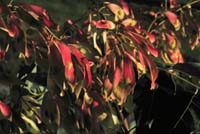
Exotics
change the habitat
Exotic
species have a negative impact on native plant communities. Exotics are
generally aggressive and spread quickly to replace native plant and wildlife
habitat. They thrive well because they have no natural pests or predators
in their new home.
Exotic species can have a dramatic effect on the appearance of a community. After invasion, the original community is changed and degraded. The combination of original species present is changed and the original balance is often difficult to restore, even with the eradicaiton of the invader.
Loss
of native species
Invasion
by non-native plant species often results in the elimination or loss of
native species, both plant and animal, if there is no intervention to stop
it.
 |
| Multiflora rose (Rosa multiflora) |
Approximately one fifth of plants now growing in Illinois are exotic. They include trees, shrubs, vines, and herbs. Of these, the shrubs pose the greatest threat to Illinois forests.
Shrubs
Examples
of shrubs introduced to improve wildlife habitat (but took over native
shrubs) are common buckthorn (Rhamnus cathartica), autumn olive
(Eleagnus
umbellata), amur honeysuckle (Lonicera maackii), and multiflora
rose (Rosa multiflora).
Other woody shrubs, such as privet (Ligustrum obtusifolium), were introduced as ornamentals. Japanese honeysuckle (Lonicera japonica), a woody vine for lawns and gardens, was introduced both as wildlife cover and as an ornamental. This vine thrives in gaps in the canopy where light enters. It deforms trees. It can retard the regrowth of a forest by killing young saplings in a forest opening.
 |
| Tree of Heaven (Ailanthus altissima) |
Weed
trees
Exotic
weed trees also pose a threat to native species and species diversity.
In Illinois, the most common problem trees are:
- white mulberry (Morus alba). It grows rapidly. The leaves are the natural food for silkworms. The tree was introduced from Japan in a nineteenth century effort to support silk production in the United States. White mulberry seeds are dispersed by birds. The plant is drought and disease resistant. It hybridizes with native red mulberry, and can eventually replace them.
- tree-of-heaven (Ailanthus altissima) pictured above. It grows very fast, takes over its site with a thicket of closely growing trees up to 80 feet tall. It produces large amounts of seeds and a toxin that prevents other species of plants from growing in the vicinity.
- amur maple (Acer ginnala). It is an small maple tree with brilliant color in the fall. It was imported from Asia as a garden ornamental, but it produces large clumps of seeds that escape to the wild and result in groves of fast-growing trees if seeds sprout in well-drained soil. As with any exotic, they may replace native species in the wild.
- golden-rain tree (Koelreuteria paniculata). These trees were introduced from Asia, mostly as ornamentals and for cover. They grow in any kind of soil, tolerate extreme temperatures, poor drainage, and drought. They produce seedlings by the thousands, so they are likely to invade natural areas and replace native species.
Of the all the herbaceous (non-woody) exotics invading Illinois forests, garlic mustard (Alliaria petiolata) poses the greatest threat. Garlic mustard invades established forests, produces great amounts of seed and chokes out the native herbaceous layer.
Other herbaceous non-native invaders include:
- common chickweed (Stellaria media). It is widespread throughout the state. It spreads by stem rooting where the stem is in contact with the ground and by seeds that land on an open spot on the ground. It grows in a thick mat as large as 50 cm in diameter. It can choke out neighboring plants and increase the conditions that promote fungal disease.
- creeping smartweed (Polygonum despotism var. longisetum). It looks like grass when it sprouts, and grows in clumps like grass. It reproduces with seeds and horizontal roots to grow 1 to 3 feet tall. It is a perennial that may live 3 or more years. It spreads to invade other species' habitat.
- ground ivy (Glechoma hederacea L. var. micrantha). It has vining stems that creep as the plant spreads. It invades quickly.
Forest pests are also more likely to have a bigger impact in smaller, fragmented forests. These insect pests include:
- the gypsy moth (Lymantria dispar), which feeds on a variety of trees, especially oak
- the European elm bark beetle, which harbored the fungus that wiped out elm forests in the 1950s.
|
|
Copyright © 2000 Illinois State Museum